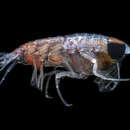Comprehensive Description
provided by Smithsonian Contributions to Zoology
Hyperia macrocephala (Dana)
Tauria macrocephala Dana, 1853:988–989.–Bovallius, 1885: 16–17; 1887b:19; 1889:81–82, figs. 1–4 [from Dana].–Chevreux, 1913:86 [in list].–Shoemaker, 1914:76.–Spandl, 1927: 156–158, fig. 3a-g.
Taura macrocephala.–Dana, 1855; pl. 68: fig. 2 [typographical error].
Hyperia macrocephala (Dana).–Bate, 1862:296, pl. 49: fig. 2 [from Dana].–Shoemaker, 1945a:291–293, fig. 2A–B.–Emison, 1968:202, fig. 11.
Hyperia galba (Montagu).–White and Bone, 1972: passim.
DERIVATION OF NAME.–From the Latin, meaning “large head.”
TYPE–LOCALITY.–Antarctic Ocean, off Oates Coast (ca. 66°S, 157°E).
DIAGNOSIS.–Head about as long as pereonites 1–2 combined; gland cone rather short. Coxa of P4 of large mature specimens pointed, projecting laterally. Outer lobe of Mxp armed with short setae only; inner lobe shorter than outer, with dense covering of setae on anterior surface and 2 terminal spines. P1–2 with very spinose distal segments. P3–4 with numerous short setae on s5–6; anterior margin of s6 and distal part of anterior margin of s5 minutely serrate. P5–7 naked except for cluster of setae at anterodistal corner of s2 of P6–7. Pleonites with sharply pointed posterolateral corners; posterior margin of epimera of pleonite 3 rather strongly convex. Uropods rather slender. Telson as long as width at base (♂) or slightly shorter (♀), about 0.4 as long as peduncle of Up3. Length up to 29 mm.
RELATIONSHIPS.–Mature individuals of this distinctive species, the largest of the genus, are easily recognized by the winglike coxa 4. Immature specimens have normal coxae. Thus far only 8 specimens have been reported, 7 from 3 localities adjacent to Antarctica and 1 from South Georgia. With the exception of Spandl’s (1927) specimen, from the stomach of an Adélie penquin, all were collected from medusae.
DISTRIBUTION.–As a result of the increased biological investigations in the Antarctic in recent years, additional specimens of H. macrocephala have come to the Smithsonian Institution, all from the McMurdo Sound area of the Ross Sea. William Emison contributed 12 specimens collected from the stomachs of Adélie penguins (Emison, 1968). Carleton Ray donated two large collections from medusae, one containing 59 females and 42 males, the other consisting of 28 females and 21 males. The first collection also contained a female Hyperiella dilatate Stebbing.
The known distribution of H. macrocephala (Figure 12) shows that it occurs around the entire Antarctic continent. Thus far the only record outside of Antarctic coastal waters is one from South Georgia (Shoemaker, 1914). From the large number, 101, found on a single medusa by Ray, it appears that H. macrocephala may be rather abundant in Antarctic waters. Curiously, it is not included by Hurley (1969) in his distribution maps of Antarctic hyperiids, although it, rather than H. antarctica, despite the latter’s specific name, appears to be the most common species of Hyperia in Antarctic waters. H. antarctica lives at greater depths and unlike H. macrocephala is not restricted to the Antarctic but has a nearly worldwide distribution.
In my opinion, Antarctic records of species of Hyperia other than H. macrocephala and H. antarctica are highly questionable.
- bibliographic citation
- Bowman, Thomas E. 1973. "Pelagic amphipods of the genus Hyperia and closely related genera (Hyperiidea: Hyperiidae)." Smithsonian Contributions to Zoology. 1-76. https://doi.org/10.5479/si.00810282.136
Hyperia macrocephala: Brief Summary
provided by wikipedia EN
Hyperia macrocephala is a species of zooplankton, an amphipod in the family Hyperiidae.
- license
- cc-by-sa-3.0
- copyright
- Wikipedia authors and editors

